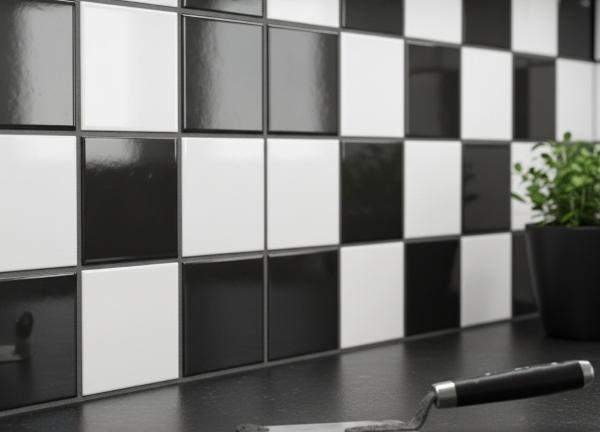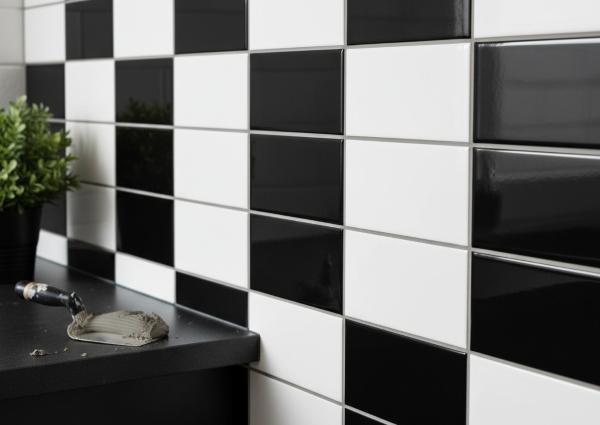A checkerboard pattern with subway tile transforms ordinary walls into striking visual statements by alternating contrasting tiles in a grid formation. This classic design approach combines the timeless appeal of subway tile with geometric precision, creating dynamic surfaces perfect for kitchens, bathrooms, and accent walls. Whether you're exploring subway tile layouts or searching for creative backsplash ideas, the checkerboard pattern offers versatility that works with both traditional and contemporary interiors.
The beauty of checkerboard subway tile lies in its ability to add movement and visual interest without overwhelming a space. Unlike standard subway tile installations, this pattern creates focal points that draw the eye and establish rhythm throughout your design. In this guide, you'll discover practical tips for executing this bold pattern, learn which tile combinations work best, and explore variations that can transform your next renovation project into something truly memorable.
Understanding the Checkerboard Subway Tile Pattern
The checkerboard pattern represents one of the most distinctive modern subway tile patterns available to homeowners today. While traditional subway tile typically runs horizontally in a brick-bond or running-bond pattern, the checkerboard creates a grid by alternating two contrasting colors or finishes in equal-sized squares.
This pattern works particularly well with square subway tiles or when standard rectangular subway tiles are installed vertically to create square units. The key to achieving professional results lies in precise planning and consistent spacing According to the National Kitchen and Bath Association, proper tile layout begins with careful measurements and dry-fitting before any adhesive touches the wall.
How Checkerboard Differs from Other Subway Tile Patterns
Unlike herringbone subway tile backsplash designs that create diagonal zigzags, or chevron subway tile arrangements with their V-shaped patterns, checkerboard maintains strict horizontal and vertical lines. This geometric precision makes it ideal for creating structured, organized spaces. The pattern also differs significantly from basketweave subway tile, which interlaces rectangular tiles to mimic woven fabric.
The US ceramic tiles market has see growing demand for creative tile patterns, with checkerboard designs experiencing renewed popularity among design-conscious homeowners seeking alternatives to standard installations.
Choosing the Right Tiles for Your Checkerboard Pattern
Color Combinations That Work
The most impactful checkerboard patterns rely on strong contrast. Classic black and white remains the gold standard, delivering maximum visual punch that works in both vintage-inspired and ultra-modern spaces. However colored subway tile options have expanded dramatically, opening new creative possibilities.
Consider these winning combinations:
- Navy and white: Sophisticated and nautical-inspired
- Charcoal gray and pale gray: Subtle yet dimensional
- Forest green and cream: Organic and calming
- Terracotta and white: Warm and Mediterranean-inspired
- Black and light blue: Bold and contemporary
When selecting tiles, visit showroom carrying diverse tile options to see actual samples in different lighting conditions. Digital images rarely capture the true depth and finish of ceramic or porcelain tiles.
Finish and Texture Considerations
Mixing glossy and matte finishes within your checkerboard pattern adds another dimension beyond color alone. The Lucida 3x9 Glossy Ceramic Subway Tile demonstrates how reflective surfaces catch light differently throughout the day, creating dynamic surfaces that change with natural and artificial lighting.
For textured options, consider the Terrazzo 3x3 Matte Finish Porcelain Mosaic Tile, which introduces speckled visual interest while maintaining the pattern's geometric integrity.
Comparison: Checkerboard vs. Other Popular Subway Tile Patterns
Pattern | Visual Impact | Installation Difficulty | Best For | Tile Waste |
Checkerboard | High contrast, bold | Moderate | Statement walls, small spaces | 10-15% |
Running Bond | Classic, subtle | Easy | Large areas, timeless looks | 5-10% |
Herringbone | Dynamic, textured | Difficult | Feature walls, floors | 15-20% |
Vertical Stack | Modern, linear | Easy | Small bathrooms, height emphasis | 5-10% |
Basketweave | Dimensional, complex | Moderate-Difficult | Vintage designs, floors | 15-20% |
Installation Tips: Creating Your Checkerboard Design
Step-by-Step Planning Guide
Step 1: Measure and Map Your Space
Calculate your wall dimensions and create a scale drawing. Determine whether your tiles will fit evenly across your surface or if you'll need cut tiles at the edges Professional tile installers recommend starting from the center and working outward for balanced patterns.
Step 2: Select Your Tile Size
Square tiles simplify checkerboard installations significantly. If using rectangular subway tiles, consider the Imagine 3x12 Matte Porcelain Subway Tile installed vertically to create square units, or the Perfection 2.5x8 Matte Porcelain Subway Tile for a more compact pattern.
Step 3: Choose Your Grout Color
Subway tile with dark grout emphasizes the grid pattern and reduces maintenance concerns. Light grout creates softer transitions but shows dirt more readily. Gray grout offers a balanced middle ground.
Step 4: Dry Lay Your Pattern
Before mixing any adhesive, lay tiles on the floor in your intended pattern. This reveals potential issues with alignment and helps you visualize the final result. Adjust your starting point if necessary.
Step 5: Install with Precision
Use tile spacers religiously to maintain consistent grout lines. The proper grouting technique requires working the material into joints at a 45-degree angle, then removing excess before it cures.
Common Installation Mistakes to Avoid
Even experienced DIYers can stumble with checkerboard patterns. Uneven grout lines become glaringly obvious in geometric designs, so invest in quality spacers and a level. Starting without proper planning often results in awkward partial tiles at borders, disrupting the pattern's rhythm.
According to renovation experts, rushing the adhesive curing process causes tiles to shift, destroying alignment. Follow manufacturer timing recommendations precisely.
Pros and Cons of Checkerboard Subway Tile Patterns
Advantages
- Visual Impact: Creates instant focal points and conversation starters
- Versatility: Works in kitchens, bathrooms, laundry rooms, and entryways
- Timeless Appeal: Classic pattern that doesn't date quickly
- Size Illusion: Can make small spaces feel larger through geometric interest
- Customization: Endless color and finish combinations available
- Easy Cleaning: Porcelain tiles clean easily with simple maintenance
Disadvantages
- Bold Commitment: Strong patterns can overwhelm small spaces if not balanced
- Installation Complexity: Requires more precision than standard patterns
- Grout Maintenance: More grout lines mean more cleaning
- Design Limitations: May clash with busy countertops or complex cabinetry
- Higher Material Costs: Pattern complexity can increase tile waste
- Trend Sensitivity: Very bold color combinations may feel dated faster
Where to Use Checkerboard Subway Tile
Kitchen Applications
Checkerboard patterns excel as subway tile kitchen ideas that balance function with personality. Behind ranges, the pattern creates natural focal points that complement rather than compete with appliances. For full-wall backsplashes, consider limiting the pattern to specific zones, using solid tiles elsewhere to prevent visual fatigue.
Open shelving pairs beautifully with checkerboard backgrounds, allowing the geometric pattern to frame displayed items. The contrast helps dishes and glassware pop visually against the structured backdrop.
Bathroom Trends
Current subway tile bathroom trends embrace checkerboard patterns in shower surrounds, tub decks, and accent walls. The pattern's inherent graphic quality makes small powder rooms feel intentionally designed rather than merely functional.
For shower installations, consider running your checkerboard pattern on one accent wall while keeping other surfaces simpler. This approach provides visual interest without overwhelming the space Understanding tile basics helps you select appropriate materials for wet areas.
Beyond Traditional Spaces
Creative homeowners are incorporating checkerboard subway tile in unexpected locations: mudroom walls, laundry room backsplashes, and even fireplace surrounds. The pattern's versatility allows it to transition between traditional and modern aesthetics depending on color choices and surrounding decor.
Maintaining Your Checkerboard Tile Installation
Once installed, your checkerboard pattern requires routine maintenance to preserve its crisp appearance. When comparing porcelain vs ceramic tiles, porcelain typically offers superior stain resistance and durability, making it ideal for high-traffic or moisture-prone areas.
Seal grout lines annually to prevent staining and moisture penetration. For daily cleaning, use pH-neutral cleaners that won't erode grout or damage tile finishes. Avoid abrasive scrubbing pads that can scratch glossy surfaces.
Regular inspection helps catch small issues before they become expensive repairs. Check for loose tiles, cracked grout, or discoloration that might indicate water infiltration.
Working with Professionals vs. DIY Installation
While checkerboard patterns are achievable for skilled DIYers, professional installation guarantees precision that's difficult to match without experience. When browsing tile selection, consider your skill level honestly. Complex patterns benefit from professional expertise, especially in bathrooms where waterproofing is critical.
For those pursuing DIY installation, invest in quality tools: a wet saw for clean cuts, proper trowels for adhesive application, and professional-grade spacers for consistent joints. Many tile suppliers offer installation workshops and resources.
Design Integration: Making Checkerboard Work in Your Space
Balance is everything when incorporating bold patterns. Pair checkerboard tile with solid-colored cabinetry, simple hardware, and minimal countertop patterns. The tile becomes the star while supporting elements remain understated.
For color inspiration and coordinating materials, explore options organized by size to ensure proportions work harmoniously with your space dimensions. Larger tiles create bolder patterns appropriate for spacious areas, while smaller tiles suit compact spaces better.
Consider lighting carefully. Under-cabinet lighting in kitchens highlights the pattern's geometry, while bathroom sconces cast interesting shadows across textured tiles. Natural light reveals color nuances that artificial light may miss.
Conclusion
Checkerboard patterns with subway tile offer a timeless yet bold design solution that elevates ordinary spaces into extraordinary environments. By carefully selecting tile colors, sizes, and finishes, and following proper installation techniques, you can create stunning focal points that showcase your personal style while adding lasting value to your home.
Whether you're tackling a complete renovation or simply refreshing a tired backsplash, the checkerboard pattern delivers maximum visual impact with classic appeal. Ready to start your tile project? Visit our showroom to explore our extensive collection and receive expert guidance tailored to your specific design vision. Our team can help you select the perfect tiles and products we carry to bring your checkerboard dream to reality.
Frequently Asked Questions
What size subway tile works best for checkerboard patterns?
Square tiles or tiles that can be arranged into square units work best. Standard 3x3, 4x4, or 6x6 inch tiles create clean checkerboard patterns. If using rectangular subway tiles, install them vertically to form square sections, typically using tiles that are twice as long as they are wide.
Can I mix different tile materials in a checkerboard pattern?
Yes, but ensure both materials have similar thickness and installation requirements. Mixing ceramic and porcelain is generally safe, but avoid combining materials with vastly different expansion rates. Always consult with your tile supplier about compatibility before purchasing.
How much extra tile should I order for a checkerboard pattern?
Plan for 15-20% overage to account for cuts, mistakes, and future repairs. Checkerboard patterns require more precise cutting than standard layouts, increasing potential waste. Always purchase all tiles from the same dye lot to ensure color consistency.
Does checkerboard pattern make a small bathroom look smaller?
Not necessarily. When executed thoughtfully with appropriate color contrast, checkerboard patterns can actually add depth and visual interest to small spaces. Lighter color combinations and smaller tiles typically work best in compact bathrooms.
What grout color works best with checkerboard tile?
Gray grout offers versatility, working well with most color combinations while hiding dirt better than white. For maximum pattern emphasis, choose grout that contrasts with both tile colors. For subtle effects, match grout to your darker tile color to create floating light squares.


